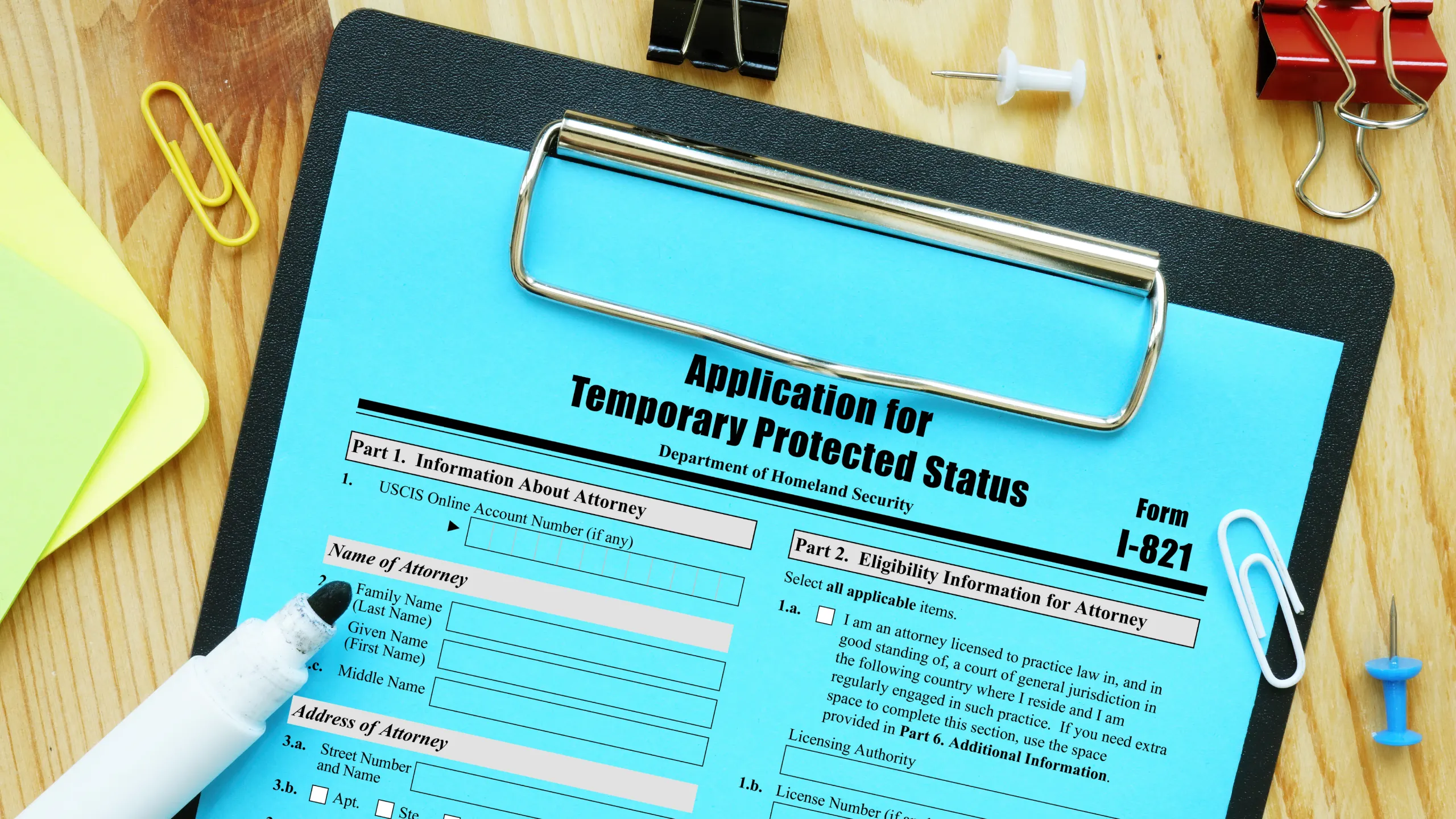TPS Designation v. Redesignation
Your Guide to Temporary Protected Status (TPS)

Temporary protected status (TPS) is a humanitarian tool utilized by the United States to help people who may be impacted by a natural disaster or armed conflict in their home country. TPS is intended to last for the length of the dangerous situation’s repercussions, but it’s not always easy to predict when an unexpected tragedy will end.
The Department of Homeland Security makes that call. Today, we’re exploring the difference between TPS designation v. redesignation and how it can impact recipients of TPS in the United States.
What Is Temporary Protected Status (TPS)?
Temporary protected status (TPS) is temporary status awarded to people from specifically designated countries if they were in the United States at a time when the Department of Homeland Security deemed it dangerous for them to travel home. Temporary protected status is a humanitarian effort intended to protect its recipients, much like asylum or refugee status.
People with temporary protected status are allowed to remain in the United States and apply for Employment Authorization Documents (EAD), also known as work permits, that will allow them to secure employment for the duration of their stay. People with temporary protected status can also apply for a travel document that will allow them to return to the U.S. after temporary overseas travel.
Recipients can remain in the United States as long as their home country remains designated for temporary protected status, they continue to obey the laws in the United States, they abide by the terms of their temporary protected status, and they re-register their status before it expires.
Temporary protected status isn’t a pathway to lawful permanent resident status (a green card), because it is meant to provide temporary protection.
People who receive temporary protected status may still be able to obtain documented permanent residency in the United States if they’re eligible through another pathway. For example, it’s not unusual for someone with temporary protected status to live in the United States for several years, meet someone, fall in love, and decide to get married. This may make a temporary protected status recipient eligible for a marriage-related green card.
Pursuing a green card won’t negatively impact temporary protected status, and if the temporary protected status recipient receives a green card, they no longer have to register or re-register for temporary protected status.
How Is Temporary Protected Status Different From Refugee or Asylum Status?
Temporary protected status is granted broadly to a group of eligible people who are already inside the United States. Refugees and asylum seekers aren’t already located within the United States. Refugee and asylum claims are made by people who approach the U.N. High Commissioner for Refugees, the border, use the CBP One app, or file affirmative applications to request consideration on a case-by-case basis. Asylum or refugee status is granted to individuals who establish a well-founded fear of persecution based on their race, religion, nationality, political opinion, or membership in a particular social group.
People who live in a country that was granted a temporary protected status designation aren’t eligible for temporary protected status in the United States if they weren’t already within U.S. borders when the designation took place. Even if someone’s home country has temporary protected status, they would have to make an asylum or refugee claim if they weren’t in the United States during the designation.
What Is a Temporary Protected Status Designation?
The United States has used temporary protected status designation since 1990. Temporary protected status is a humanitarian designation awarded to certain non-immigrants if the United States government feels that it would be dangerous to send them back to their home country at the time when they intended to leave (or were required to leave) the United States.
Who Designates Temporary Protected Status?
The Department of Homeland Security monitors ongoing situations around the world and how their impact could affect global safety, as well as the safety of the people who live in affected countries.
If the Department of Homeland Security feels that a situation is urgent, they may issue temporary protected status for people within the United States who are nationals of a designated country.
What Causes a Country To Receive Temporary Protected Status Designation?
Any situation that could be considered dangerous can cause a country to receive a TPS designation. Examples include, but are not limited to, some of the following situations:
- Natural disasters like tsunamis, devastating earthquakes, or strong-category hurricanes.
- War or ongoing armed conflict.
- A severe disease outbreak or epidemic contained outside of the United States.
- Any other temporary, extraordinary condition that isn’t expected to leave a country permanently unsafe.
Which Countries Have Temporary Protected Status?
Because TPS is a real-time response to unpredictable events, the list of countries with TPS designation is subject to change at any moment. Countries may be added if an ongoing situation causes a threat of real harm to the nationals of these countries. Countries can be removed from the list if, at any point, the Department of Homeland Security considers a situation to be resolved.
Countries with TPS at the time of writing this article are:
- Afghanistan.
- Cameroon.
- El Salvador.
- Ethiopia.
- Haiti.
- Honduras.
- Myanmar (Burma).
- Nepal.
- Nicaragua.
- Somalia.
- South Sudan.
- Sudan.
- Syria.
- Ukraine.
- Venezuela.
- Yemen.
What Is Temporary Protected Status Extension?
TPS extension occurs when the original period of temporary protected status designation ends, but the Department of Homeland Security still believes that a designated country isn’t safe for return. This could be due to ongoing conflict or dangerous infrastructure problems that have yet to be resolved. Extension of a temporary protected status designation effectively leads to a lengthening of TPS eligibility for people who already receive protection.
When temporary protected status is extended to a country, nationals of that country who currently receive temporary protected status in the United States will be able to re-register their temporary protected status and remain in the United States as long as they continue to meet the eligibility requirements and abide by temporary protected status guidelines.
What Is a Temporary Protected Status Redesignation?
Temporary protected status redesignation offers a unique opportunity to people who live in a temporary protected status designated country but were not eligible to request temporary protected status during the initial designation of their country of origin. If a situation in a designated country worsens (or at least does not become measurably better), temporary protected status can be formally designated a second time.
People who were within the United States when the redesignation took place will be eligible to request temporary protected status even if they weren’t in the United States for the initial designation. Redesignation acts as a second chance to provide humanitarian safety consideration to a second round of eligible people who may have missed out the first time.
Temporary protected status can be redesignated whenever the Department of Homeland Security reviews the situation in a country eligible for temporary protected status and makes a determination that the country should be redesignated. Venezuela was recently redesignated for temporary protected status due to the ongoing instability within the country. Ukraine was also recently redesignated as armed conflict persists.
What Happens to Temporary Protected Status Recipients When Their Country Is Redesignated?
People who are already receiving temporary protected status are currently in the United States during the redesignation of their home country. In essence, redesignation simply alludes to the fact that the duration of their temporary protected status will continue for longer. There’s no reason for them to begin the process of seeking temporary protected status for a second time because they’re already properly registered.
How Do You File for Temporary Protected Status After Redesignation?
The Department of Homeland Security posts designation dates, redesignation dates, registration dates, and re-registration dates for temporary protected status eligible countries. You’re eligible to apply for temporary protected status if you were in the United States during the redesignation date of your country of origin.
The Department of Homeland Security provides detailed information about the registration process for each country. The filing process is usually the same, requiring eligible applicants to utilize USCIS Form I-821.
Applicants are allowed to file for an Employment Authorization Document (EAD) at the same time. An EAD makes it possible for temporary protected status recipients to work in the United States. Since processing times can be long for EAD paperwork, it’s best to apply for both at the same time to avoid disruptions in your ability to financially support yourself during your stay in the United States.
Do You Need Assistance With Temporary Protected Status?
If you need assistance filing for temporary protected status after your country of origin was redesignated, the immigration law team at Cohen, Tucker + Ades may be able to help. Contact us for a consultation on your temporary protected status eligibility. After reviewing the details of your case, we’ll be able to assist you with your options.
Sources:
Directory of Visa Categories | United States Department of State | Bureau of Consular Affairs
Executive Office for Immigration Review | Temporary Protected Status (TPS)
Not sure which option is right for you? Request a confidential consultation today.

